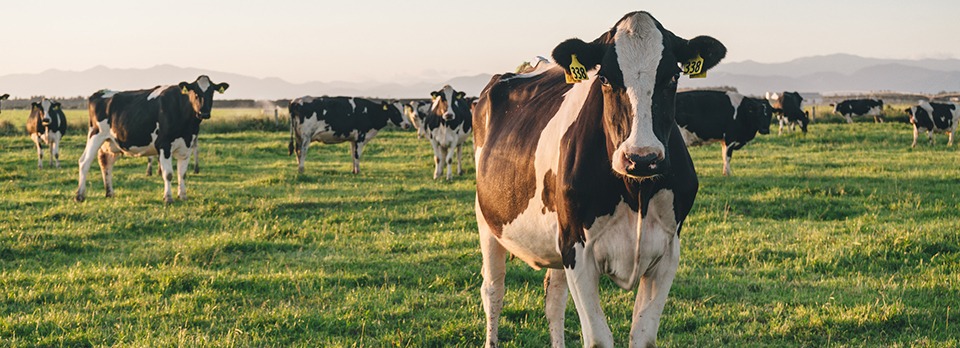
I recently wrote an article on the unseen impact of milk fever and how widely spread this issue can be without correct mineral support. The challenge of calcium deficiency is a fairly large topic and it’s important to now cover the other key information farmers should consider in managing the pasture dominant diets of our dairy herds at this critical time.
Pasture still makes up a significant portion of the diet for many of New Zealand’s springer cows. Our lush pasture and high growth levels lead to higher than optimal levels of potassium. Levels in the plant can often supply potassium in excess of 300% of a cow’s daily nutritional requirement. High potassium not only restricts the animal’s ability to uptake other essential minerals, it also changes the acid/alkali balance of the body which can seriously impact the body’s ability to release hormones critical to calcium utilisation during calving and early lactation.
The DCAD system of feeding involves adding acid forming salts to the diet of springer cows in an attempt to further drive this metabolic acid/alkali balance slightly more towards the acid range, thus facilitating the release of the hormones required to release calcium. Provided this feeding system is correctly implemented, when compared to other options, this approach is also very cost effective.
CALCIUM OR NO CALCIUM?
The calibration used in the correct formulation of these diets is expressed in total milliequivalents (mEq). An unmodified pasture-based springer cow diet can typically have a DCAD anywhere from +350 to +550 mEq’s or even higher, dependent on the level of pasture being fed. The aim is to get the mEq level of the diet down as low as possible. Under New Zealand conditions that normally means somewhere between -15 to +120 mEq’s. This is achieved by manipulating the feed sources in the diet and then adding a specific blend of acid forming salts. With the correct blend, palatability is maintained while reducing the total feed DCAD levels substantially.
There has always been strong debate around the use of calcium during the dry and springer period, and for good reason. This has usually focused on the element itself rather than form. Adding lime, the most common form of calcium, has been clearly shown to negatively affect the natural processes involved in pulling calcium from the bone. Leading up to and during early lactation, cows require large amounts of calcium – levels much higher than can be supplied through the digestive process. Due to the extremely high levels of calcium required for colostrum production the body must be able to efficiently draw on reserves (bone), and anything that compromises this ability can lead to a downer cow or a cow that goes through the season sub-clinically calcium deficient. This can lead to lower immunity, poorer reproductive outcomes, along with other issues.
When answering the question, should I add calcium or shouldn’t I, every situation needs to be looked at differently.
Questions to consider:
1. What is the likely calcium status of the pasture? (Herbage/feed tests should be a regular part of your on-farm testing regime)
2. What crop feeds have been added to the diet? (Many crops are naturally low in calcium)
3. What other feeds make up a significant part of the diet, e.g. PKE, DDG, fodder beet etc…?
Some herds of course will be at higher risk of calcium deficiency due to age and breed, but at the end of the day if you do the calculations based on dietary requirement you shouldn’t have too many issues.
If feeds such as maize silage and fodder beet, make up a significant portion of the seasonal diet, then the calcium question is easy to answer. If you are going to feed either of these common winter supplements in any reasonable quantity, you will need to be supplementing at least some calcium.
THE NEXT QUESTION IS, WHAT FORM?
This decision depends on the time of season when the supplement is given.
It is known from laboratory testing done here in New Zealand that the various forms of calcium vary markedly in their ability to deliver rumen and intestinally available calcium. We have tested micronised gypsum (prill form), micronised lime (prill form), lime flour (industry standard product) and calcium chloride under laboratory tests designed to closely replicate ruminant digestion. Our tests showed the 48-hour calcium release of the two micronised lime products were both very low, 8% and 11% respectively. Interestingly, calcium release from both gypsum and calcium chloride were very similar. In these tests calcium chloride and gypsum showed a much higher more rapid release of calcium, levels of 28% and 30% respectively. Our testing indicates that the issue with calcium release and uptake is therefore far more related to form than it is to dose volume.
We have always advocated the supplementation of at least some calcium to all springer cows in our transition diets. Our approach however is to supplement the required calcium in the form of calcium chloride and gypsum, providing calcium in a very available form but at the same time maintaining a low DCAD through the use of a range of acid forming salts.
To achieve successful outcomes these mixes are specifically formulated to suit New Zealand conditions. Through careful blending and the use of palatants, they are purposely built to maintain maximum palatability. These blends efficiently address the influence of potassium at the same time combating calcium deficiency.
Article: Chris Balemi, Agvance Nutrition.